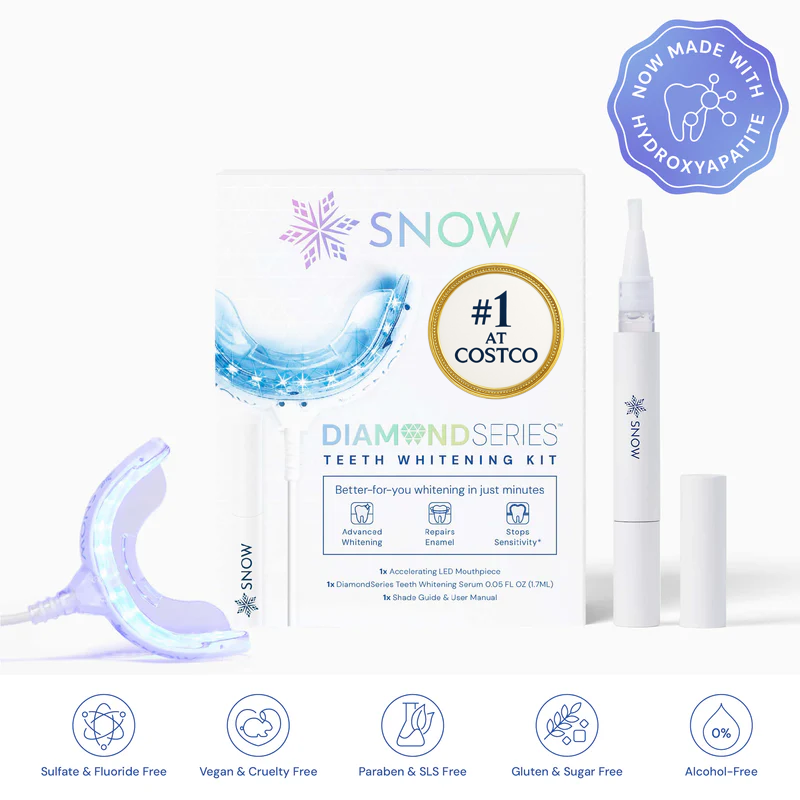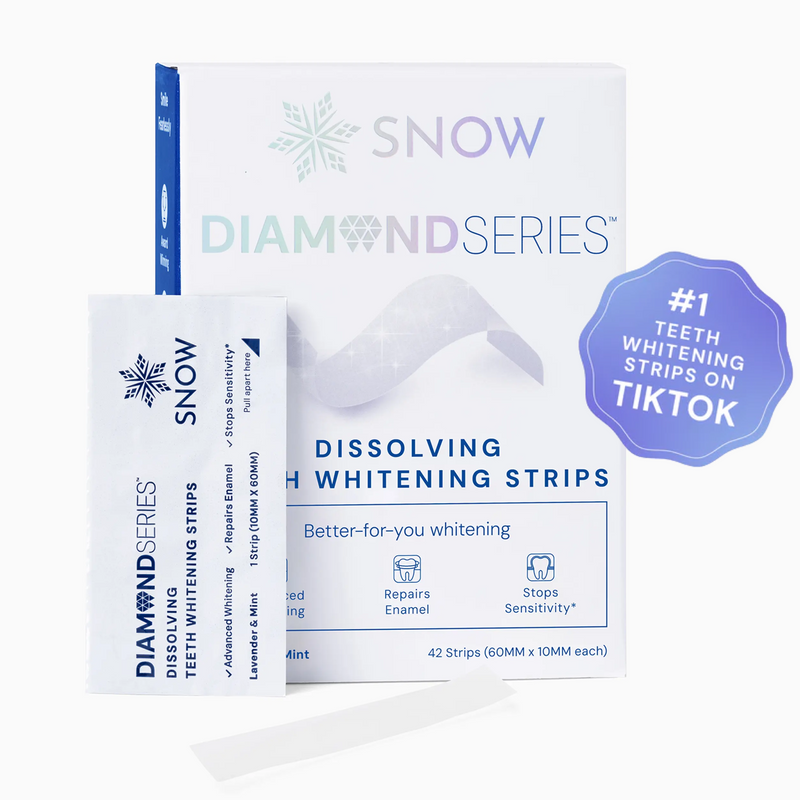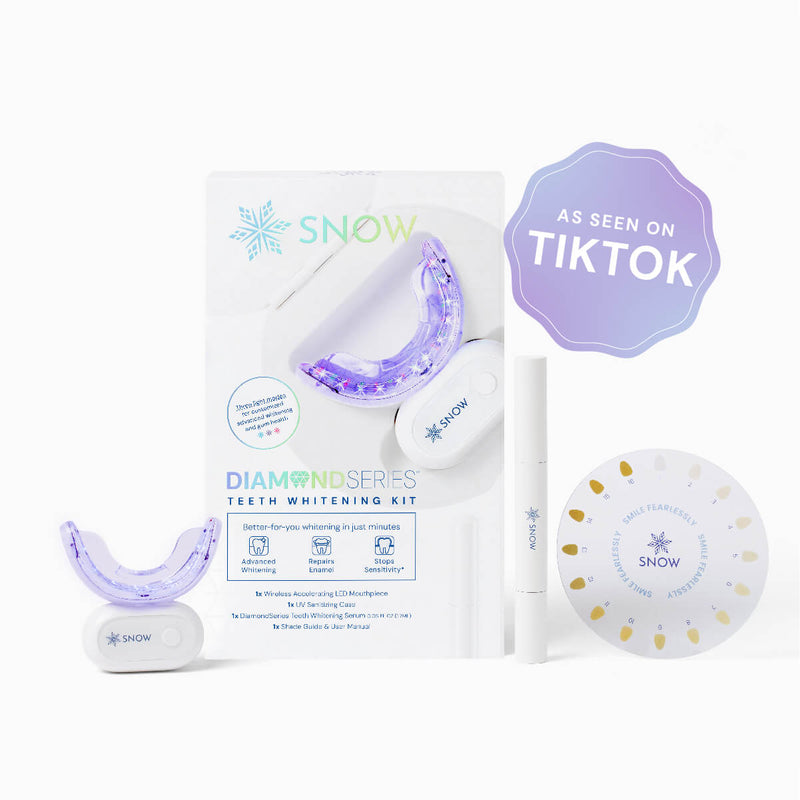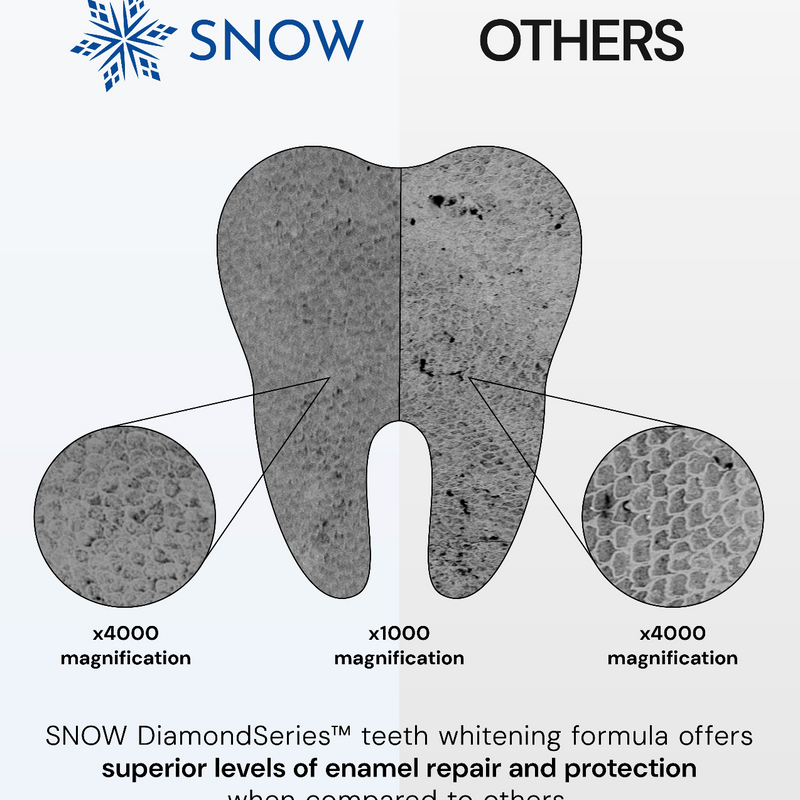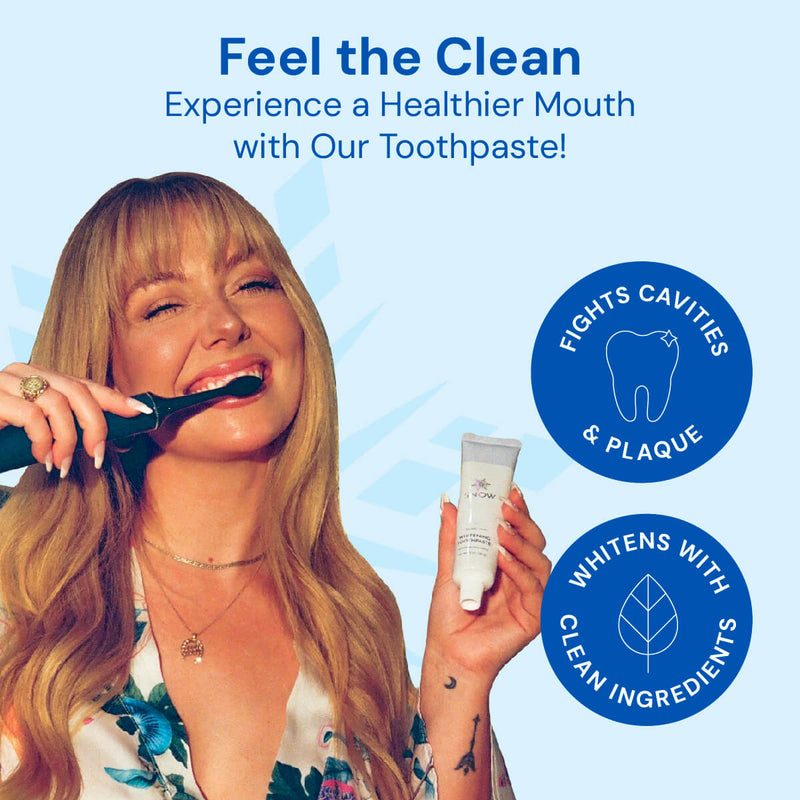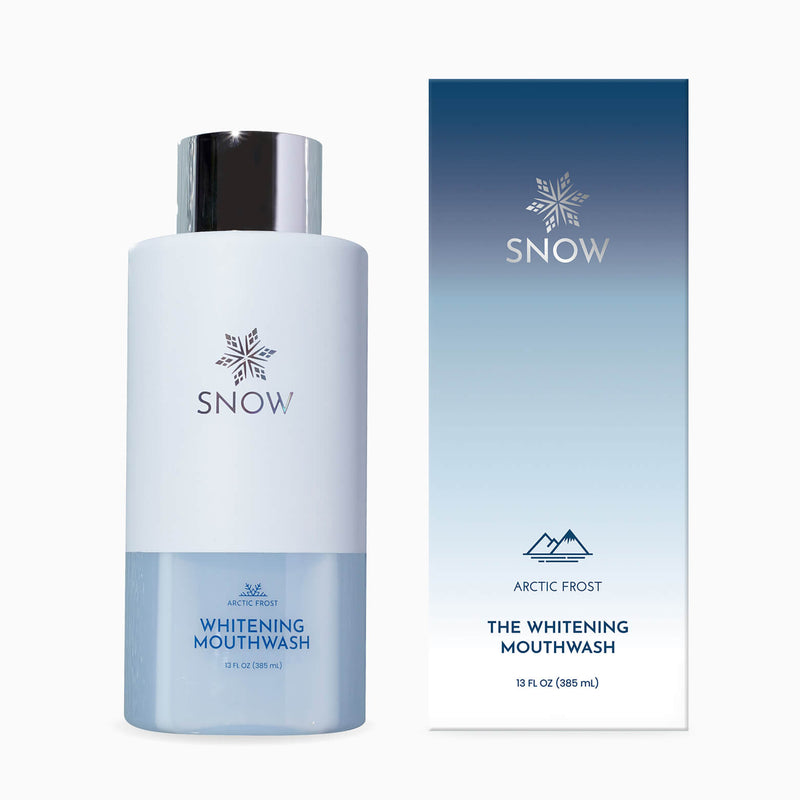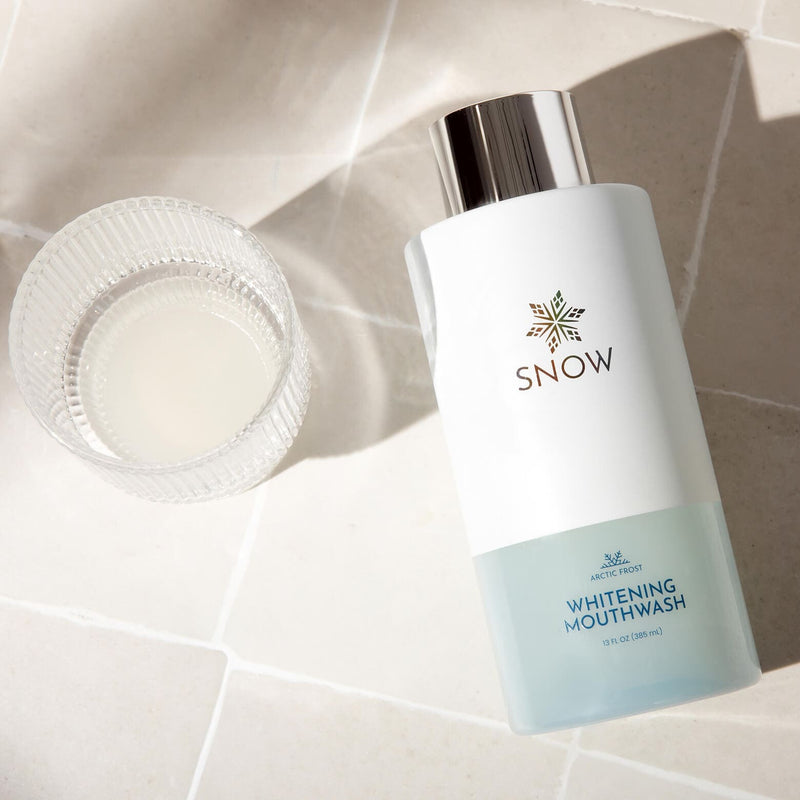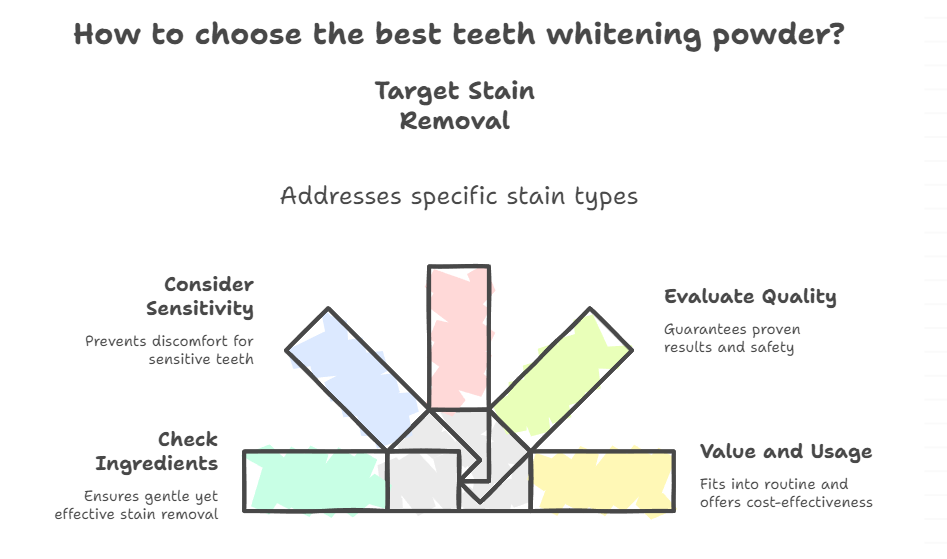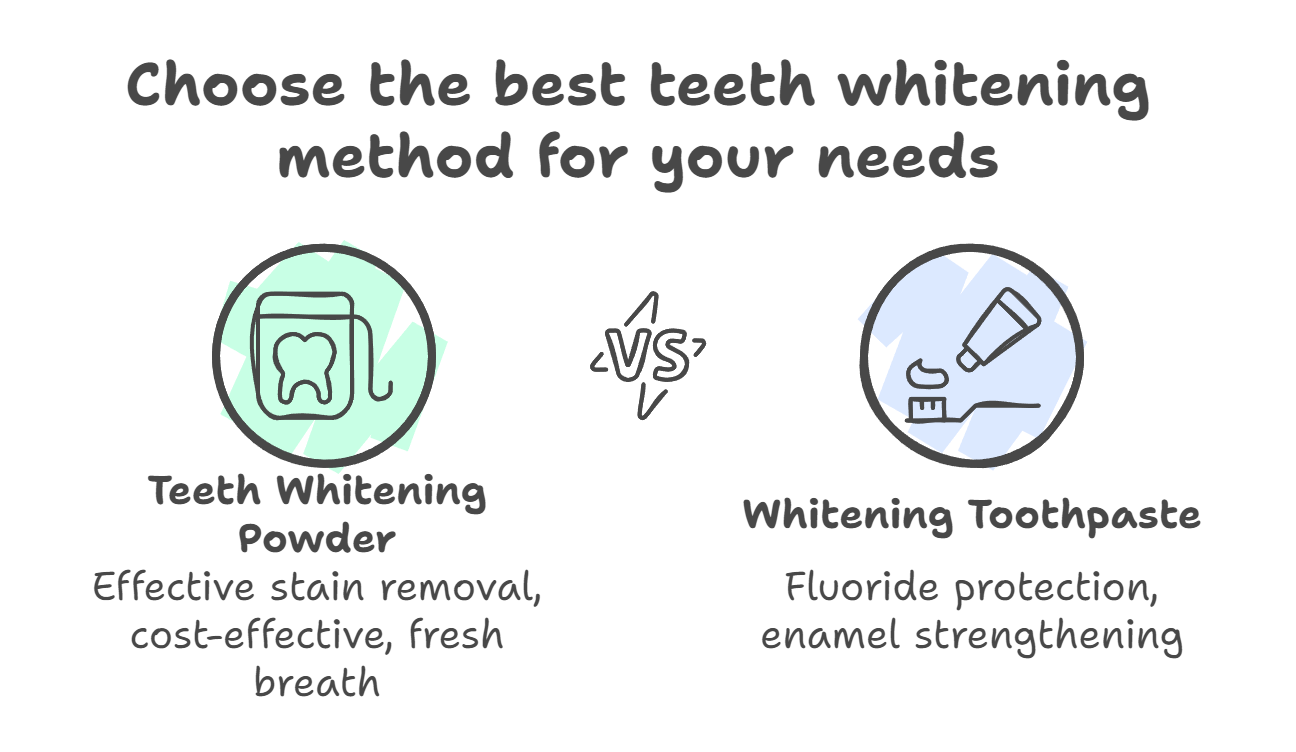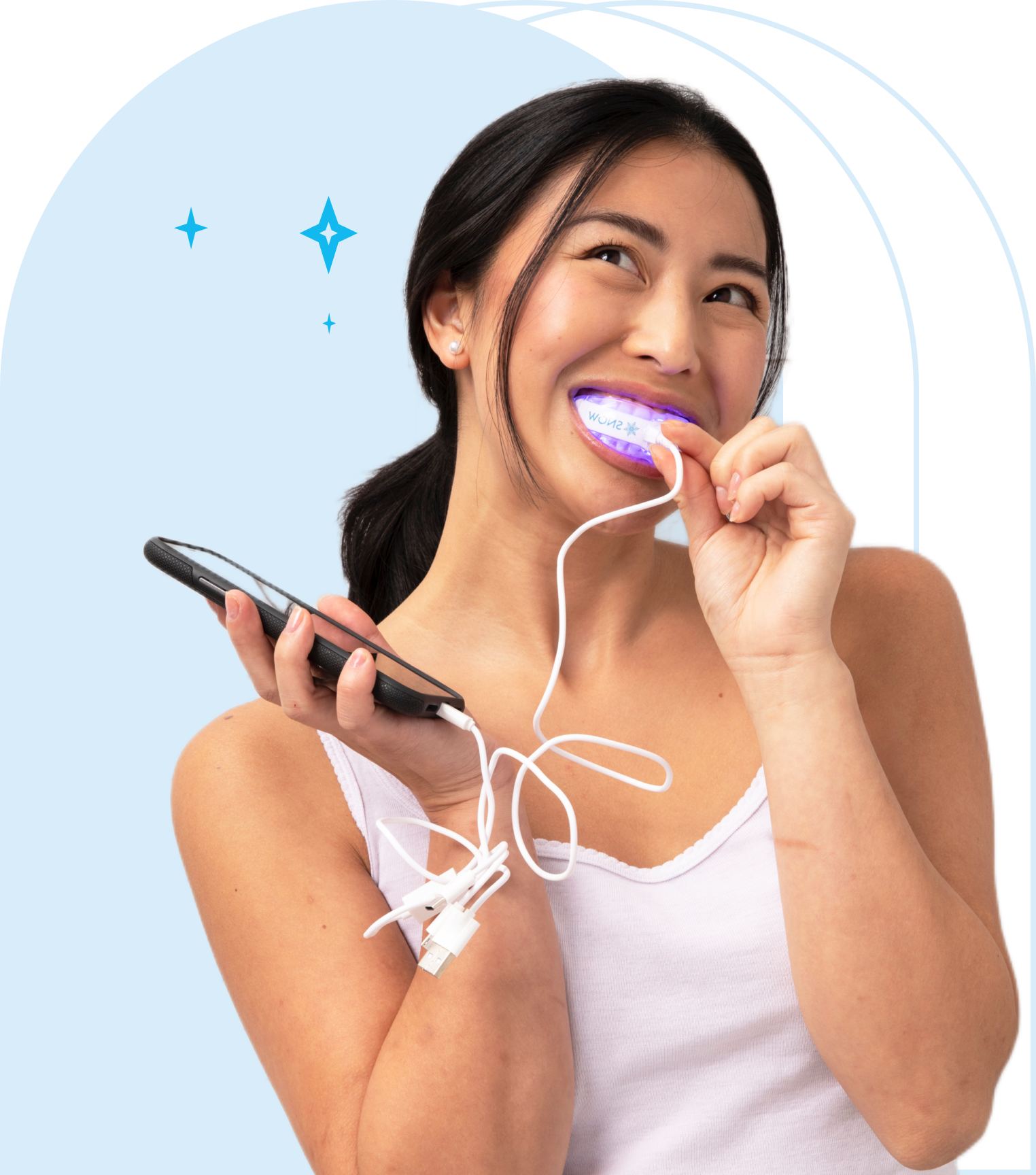Curious about how to use teeth whitening powder correctly?
Many people turn to whitening powders to lift surface stains, but improper use can lead to enamel erosion or increased sensitivity.
This guide outlines how to use teeth whitening powder effectively and safely, helping you achieve visible results without harming your teeth.
From selecting the right formula to using proper brushing techniques, we'll cover everything you need to know. Teeth whitening powder is free from harmful peroxides and parabens, making it a safer option for enamel.
Key Takeaways
-
Teeth whitening powder should be applied on a slightly damp toothbrush, using gentle brushing techniques to avoid enamel erosion.
-
For optimal results, use teeth whitening powder two to three times a week, combine it with regular fluoride toothpaste, and maintain good oral hygiene habits.
-
Visible improvements can be expected within 7-14 days for mild stains, while deeper stains may take 2-4 weeks of consistent use to show results.
-
Many users notice a huge difference in the whiteness of their teeth after consistent use.
How to Use Teeth Whitening Powder Safely and Effectively
Before diving into your whitening routine, it's important to understand what makes teeth whitening powder work, and how to set yourself up for safe, noticeable results. These powders often contain mild abrasives like baking soda or calcium carbonate, which help lift surface stains without harming your enamel.
Not all powders are created equal, so it’s essential to choose one that suits your dental needs, especially if you have sensitive teeth or thin enamel. Pay attention to product ingredients, brush gently, and follow usage recommendations to avoid enamel erosion or gum irritation.
By starting with the right product and mindset, you're already on the path to a brighter, healthier smile.
How to Choose the Best Teeth Whitening Powder for Your Smile
Choosing the right teeth whitening powder is key to achieving visible results without compromising your oral health. With so many products on the market, here’s what to look for:
-
Check the ingredients: Look for powders containing mild abrasives like calcium carbonate or sodium bicarbonate, which effectively lift surface stains while being gentle on enamel. Baking soda and activated charcoal are also popular for their natural whitening and detoxifying properties.
-
Consider sensitivity: If you have sensitive teeth or thin enamel, opt for fluoride-free and peroxide-free formulas. These are less likely to irritate your gums or cause post-use discomfort.
-
Targeted stain removal: Coffee or tea drinkers should look for whitening powders specifically formulated to tackle stubborn stains. Some dentist-formulated options are designed to help strengthen enamel while removing discoloration.
-
Evaluate product quality: Choose clinically tested products with positive reviews and proven results. Look for visible improvement timelines, ingredient transparency, and clear usage guidelines.
-
Value and usage: Consider the cost per use and whether the powder fits easily into your oral care routine, 2–3 times a week is typical. A little goes a long way, so even small jars can last a while.
By selecting a whitening powder that aligns with your teeth sensitivity, lifestyle, and whitening goals, you’ll set yourself up for a brighter smile—safely and effectively.
Step-by-Step Application Process
Using teeth whitening powder might seem straightforward, but following a step-by-step process ensures you get the best results. We’ll break down the process into simple steps:
-
Wet your toothbrush.
-
Apply the teeth whitening powder.
-
Brush your teeth thoroughly.
-
Rinse your mouth thoroughly.
Teeth whitening powder is formulated to be safe and effective for natural teeth, helping to lift stains without causing damage. It removes deep-set stains from coffee, tea, wine, and natural aging for a visibly whiter smile.
Keep in mind that it can be a bit messy, so prepare accordingly. A small amount of whitening powder is enough; excess can lead to messiness.
Step 1: Wet Your Toothbrush
The first step in using teeth whitening powder is to wet your toothbrush. This step is vital because a slightly damp toothbrush helps the powder stick to the bristles better. Make sure your toothbrush bristles are just slightly moistened. If they are too wet, the powder will not adhere properly; if too dry, it won’t spread evenly on your teeth.
To achieve the right level of dampness, run your toothbrush under the tap for a second or two, then shake off any excess water. This preparation ensures that your toothbrush is ready for the whitening powder, optimizing its effectiveness while brushing.
Step 2: Dip into Whitening Powder
Once your toothbrush is ready and to ensure it stays fresh and clean, follow these steps: (why your toothbrush might smell and how to keep it clean)
-
Dip it into the teeth whitening powder.
-
Use a small amount—just enough to cover the tips of the bristles.
-
This ensures that the powder is evenly distributed across your teeth, providing a consistent whitening effect.
After dipping, proceed to brush your teeth as you would normally. The small amount of powder is sufficient to tackle surface stains and gradually lead to a brighter smile. Remember, less is more when it comes to whitening powder.
Step 3: Brush Gently
Brushing gently is the key to protecting your enamel while using teeth whitening powder. Aggressive brushing can lead to enamel erosion, which defeats the purpose of trying to achieve a whiter smile. Instead, use gentle, circular motions to effectively remove surface stains without harming your teeth.
Focus on each section of your mouth equally to ensure all areas receive the same attention. This technique not only helps in removing stains but also promotes better oral health overall. Regular use of teeth whitening powder can also help reduce plaque buildup, supporting overall oral health.
Step 4: Rinse Thoroughly
After brushing, rinse your mouth thoroughly. Swish water around your mouth multiple times to remove all remnants of the whitening powder. This step is crucial to avoid any residue that might cause discomfort or affect the taste in your mouth.
Proper rinsing also helps remove any remaining stains that brushed brushing might have loosened. This ensures that your brush teeth are not only whiter but also clean and free from any powder residue, promoting fresher breath.
How Often Should You Use Teeth Whitening Powder?
To maintain healthy enamel, consider the following recommendations:
-
Use teeth whitening powder daily two to three times a week.
-
Avoid overusing the powder, as it can lead to thin enamel erosion.
-
Understand that enamel erosion can cause sensitivity and other dental issues.
-
Limit the frequency of use to ensure your enamel remains strong and healthy, strengthening enamel and protect enamel. Additionally, pay attention to how your teeth feel after using the whitening powder.
A balanced oral care routine is necessary. This includes using teeth whitening powder in conjunction with regular brushing and flossing to keep your teeth in optimal condition. This routine helps achieve whiter teeth and a whiter smile without compromising dental health and whitens teeth.
Benefits of Using Teeth Whitening Powder
Teeth whitening powder offers several benefits, making it a popular choice for those seeking a brighter smile. One of the key advantages is its effectiveness in removing stubborn stains caused by coffee, tea, and other dark-colored foods and drinks. Additionally, it is safe for sensitive teeth, using a gentle, hydrogen peroxide-free formula that minimizes discomfort. Teeth whitening powder also enhances gum health and leaves breath feeling fresh. Many people also explore various whitening products, including charcoal teeth and charcoal teeth whitening powder and tooth whitening powder, to enhance their results.
Compared to regular whitening toothpaste, teeth whitening powder:
-
Is more effective at removing stains
-
Is cost-effective
-
Lacks fluoride
-
Leaves your teeth feeling exceptionally clean
-
Freshens breath, contributing to better overall oral hygiene
-
Provides fresh breath by neutralizing odor-causing bacteria, often using natural ingredients like mint for long-lasting minty freshness
Teeth whitening powders generally lack fluoride protection, which is essential for strengthening enamel.
-
Is more effective at removing stains
-
Is cost-effective
-
Lacks fluoride
-
Leaves your teeth feeling exceptionally clean
-
Freshens breath, contributing to better overall oral hygiene
-
Provides fresh breath by neutralizing odor-causing bacteria, often using natural ingredients like mint for long-lasting minty freshness
Combining Whitening Powder with Regular Toothpaste
For optimal results, first apply toothpaste teeth whitening powder. Then, follow up by brushing with regular fluoride toothpaste. Compared to traditional toothpaste, teeth whitening powder typically contains different ingredients, comes in a powder form rather than a paste, and is often more effective at removing surface stains for a brighter smile. This sequence ensures that the whitening powder removes surface stains first, allowing the fluoride toothpaste to strengthen enamel and protect against cavities.
Alternating between whitening powder and fluoride toothpaste helps maintain the whitening effects while ensuring your enamel remains protected. This balanced approach maintains both the aesthetic and health aspects of your teeth.
Expected Results Timeline
Teeth whitening powder can yield noticeable results quickly, but timelines may vary; results vary based on factors such as the severity of stains, frequency of use, and the type of whitening powder that can all influence how quickly you’ll see improvements.
Visible Improvement in 7–14 Days
Typically, you can expect to see visible improvement in mild surface stains within just a few uses of consistent use. This initial phase often includes a reduction in new stains around the gums and an overall brighter smile, helping to combat daily stains and yellow stains.
The effectiveness of teeth whitening powder depends on various factors, including your diet and oral hygiene habits. Those who follow the recommended usage and maintain good oral hygiene are likely to see the most significant improvements.
Long-Term Stain Removal
For moderate stains, noticeable whitening results typically appear within 2 to 4 weeks of consistent use. Long-term use of teeth whitening powder is particularly effective for deeper, more stubborn stains that may not be eliminated through short-term use.
Consistency and good oral hygiene practices are key to achieving and maintaining optimal results. By sticking to a daily brushing routine, you can effectively target and remove deeper stains, ensuring a long-lasting, fresher smile and the best teeth for a brighter smile that are clinically proven, giving you a confident smile.
Tips for Maintaining a Brighter Smile
To preserve the results of teeth whitening and support overall oral health, consider the following preventive strategies:
-
Minimize intake of chromogenic substances: Limit consumption of coffee, tea, red wine, dark berries, and other pigmented foods and beverages known to contribute to extrinsic staining.
-
Reduce dietary acids: Frequent exposure to acidic foods (e.g., citrus fruits, carbonated drinks) can erode enamel, making teeth more vulnerable to staining.
-
Rinse with water post-consumption: Swishing with water after meals or acidic beverages may help neutralize pH levels and remove residual pigments.
-
Incorporate fluoride-based products: Fluoride toothpaste and mouthwash assist in enamel remineralization and protect against demineralization caused by whitening agents.
-
Practice meticulous oral hygiene: Brushing twice daily and flossing once per day reduces plaque retention, which can trap staining compounds.
-
Use a soft-bristled toothbrush: This reduces the risk of enamel abrasion, especially after exposure to whitening products.
-
Chew sugar-free gum: Stimulates salivary flow, which aids in neutralizing acids and naturally cleansing the oral cavity.
-
Avoid tobacco use: Smoking or smokeless tobacco significantly increases the risk of staining and long-term oral health issues.
-
Attend routine dental cleanings: Professional prophylaxis can help manage stain accumulation and monitor enamel health post-whitening.
Potential Risks and Precautions
While teeth whitening powder is generally safe, it’s important to be aware of potential risks and take necessary precautions. Consulting a dental professional before starting any whitening regimen is advisable, especially for individuals with sensitive teeth or existing dental issues. Overuse of whitening powder can lead to enamel erosion and increased tooth sensitivity.
Applying the powder properly and in moderation helps avoid these risks. Using the powder as directed helps maintain tooth enamel while achieving the desired whitening effects. For deeper stains, professional treatments may be necessary to achieve the best results with calcium carbonate.
How To Use Teeth Whitening Powder Wrapped Up
Using teeth whitening powder can be a simple, effective way to brighten your smile at home—especially when applied correctly and paired with strong oral hygiene habits. While it’s a great option for surface stains, consistency and care are key to long-term success.
-
Always brush gently to avoid enamel erosion.
-
Use whitening powder 2–3 times per week for best results.
-
Combine with fluoride toothpaste to maintain enamel strength.
Looking for something gentler and less messy? SNOW’s powder-free whitening options are designed for easy use at home. Brighten your smile without compromising comfort.
Frequently Asked Questions Around Teeth Whitening Powder
How do you use whitening powder?
To use whitening powder, start by slightly wetting your toothbrush, then dip it into the powder. Gently brush your teeth for 1–2 minutes to effectively remove surface stains while protecting your enamel.
Do you use whitening powder before or after brushing?
It is best to use whitening powder before brushing with regular fluoride toothpaste. Whitening powder removes surface stains, and following up with toothpaste strengthens and protects your enamel.
How long should I leave teeth whitening powder on?
You should brush with the whitening powder for about 1 to 2 minutes, then rinse thoroughly. There is no need to leave the powder on your teeth beyond brushing, as its stain-removing action occurs during brushing.
Do I use teeth whitening powder with toothpaste?
Yes, using teeth whitening powder along with regular fluoride toothpaste is recommended. Whitening powder removes stains, while toothpaste helps protect enamel and maintain overall dental health.















































